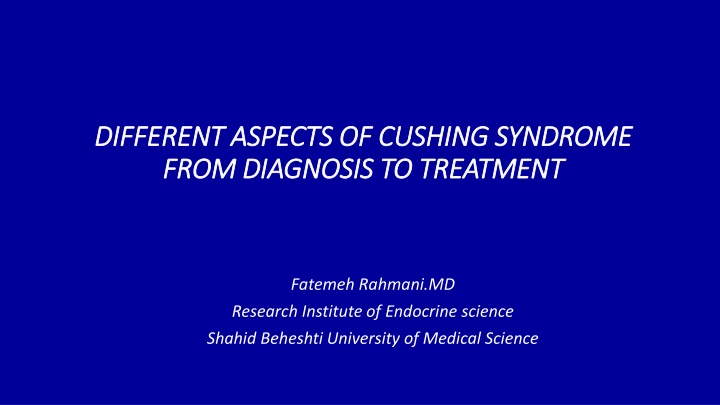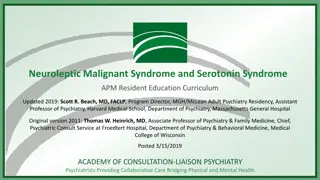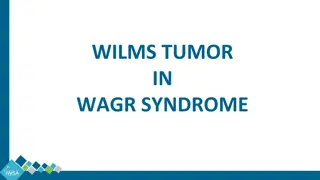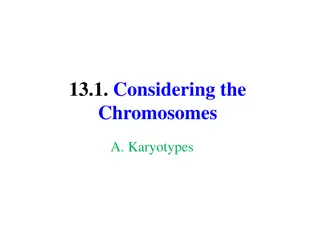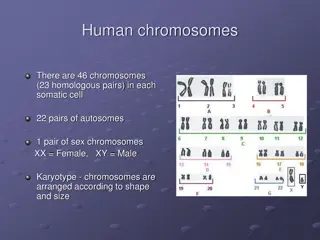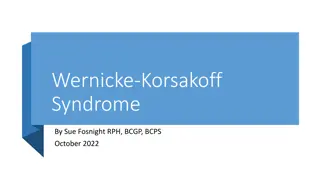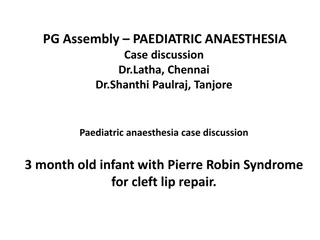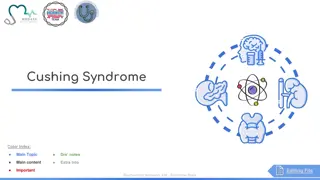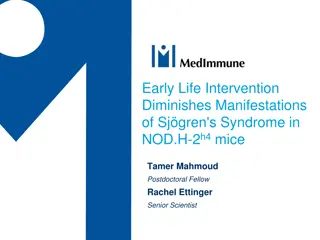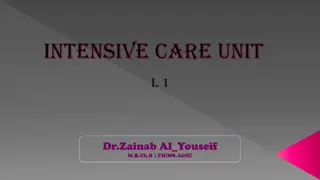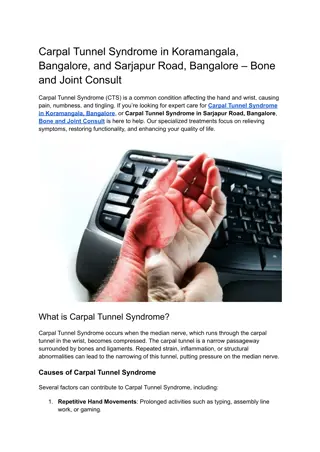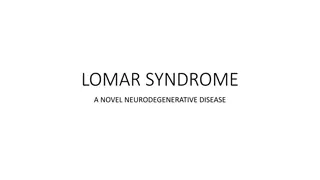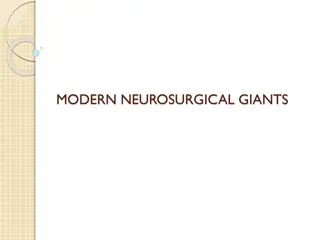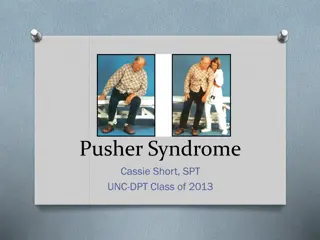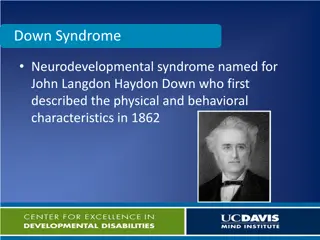Overview of Cushing Syndrome: Diagnosis to Treatment
Cushing syndrome, a complex endocrine disorder, presents with various clinical manifestations and requires proper diagnosis and treatment. Learn about different aspects of Cushing syndrome from clinical features to classification of causes, diagnostic tests, and appropriate investigations.
Download Presentation

Please find below an Image/Link to download the presentation.
The content on the website is provided AS IS for your information and personal use only. It may not be sold, licensed, or shared on other websites without obtaining consent from the author.If you encounter any issues during the download, it is possible that the publisher has removed the file from their server.
You are allowed to download the files provided on this website for personal or commercial use, subject to the condition that they are used lawfully. All files are the property of their respective owners.
The content on the website is provided AS IS for your information and personal use only. It may not be sold, licensed, or shared on other websites without obtaining consent from the author.
E N D
Presentation Transcript
DIFFERENT ASPECTS OF CUSHING SYNDROME DIFFERENT ASPECTS OF CUSHING SYNDROME FROM DIAGNOSIS TO TREATMENT FROM DIAGNOSIS TO TREATMENT Fatemeh Rahmani.MD Research Institute of Endocrine science Shahid Beheshti University of Medical Science
Agenda Case presentation 1 Clinical manifestation Classification Diagnostic tests Case presentation 2 Case presentation 3 Treatment
Case 1 A 34-y old man is referred because of weight gain(13.6 kg) over the past 3 years without skin changes or muscle weakness. PMH: HTN,epilepsy ,a recent diagnosis of IGT. DH: lamotrigine,captopril , atorvastatin. PH/E:central obesity,few pale striae over the abdominal wall but no other skin changes, no proximal myopathy, Bp is 150/90 and BMI is 38 kg/m2 Laboratory test results: Na=138 mEq/L (136-142 mEq/L) TSH =2.4 mIU/L (0.5-5.0mIU/L) K=4.9 mEq/L (3.5-5 mEq/L) FreeT4=1.3 ng/dl (0.8-1.8 ng/dl) Cr=0.9 mg/dl (0.7-1.3mg/dl) Glucose=175mg/dl overnight dexamethason supression test =14mcg/dl
Which of the following is the most appropriate next investigation? A)Perform adrenal CT B)Perform pituitary MRI C)Perform a 2-day low-dose dexamethasone supression test D)Stop lamotrigine and perform another 1-mg ODST
Clinical features Obesity Reproductive organs Psychiatric Features Bone Skin Muscle Cardiovascular features Infections Metabolic and Endocrine features
Who should be tested? Patients with unusual features for age (e.g. osteoporosis, hypertension) Patients with multiple and progressive features,particularly those that are more predictive of Cushing s syndrome Children with decreasing height percentile and increasing weight Adrenal incidentaloma
Classifications of causes of Cushing Syndrome ACTH Dependent Causes Cushing disease Ectopic ACTH syndrome Ectopic CRH syndrome Macronodular adrenal hyperplasia Iatrogenic (treatment with 1-24 ACTH) ACTH Independent Causes Adrenal adenoma and carcinoma PPNAD and Carney syndrome McCune-Albright syndrome Iatrogenic (prednisolone, dexamethasone)
Other Causes of Hypercortisolism (pseudo Other Causes of Hypercortisolism (pseudo- -Cushing Syndrome) Cushing Syndrome) Pregnancy Depression and other psychiatric conditions Alcohol dependence Morbid obesity Poorly controlled DM
Pseudo-Cushing syndrome Present with a similar clinical phenotype except Cutaneous(easy bruising, thining, friability) Proximal muscle weakness The circadian rhythm of cortisol is preserved Treatment of these underlying conditions will lead to resolution of symptoms In clinical scenario , where the test results are discordant in a patient with mild hypercortisolism,F/U is recommended for monitoring progression of symptoms and for repeat testing
Pregnancy HTN and DM are the most common sign of CS in pregnancy Pregnancy is associated with a 3-fold increase in plasma cortisol ,UFC also rises, and dexamethasone does not suppress plasma cortisol to the same degree as the nonpregnant state Recommend the use of UFC and against the use of dexamethasone testing in the initial evaluation of pregnant women Any adrenal or pituitary adenomas should be excised Metyrapone,which is not teratogenic,has been effective in many cases in controlling the hypercortisolism
Investigation of Patients With Suspected CS Does this patient have Cushing Syndrome? Circadian Rhytm of Plasma Cortisol Late night salivary Cortisol Urinary Free Cortisol Overnight Dexamethasone Suppression Test Low-dose Dexamethasone suppression Test If the answer is yes ,what is the cause?
Circadian rhytm of plasma cortisol Ideally patients should be hospitalized for 24-48 h before test A midnight cortisol level >7.5 mcg/dl indicates Cushing syndrome If a serum cortisol value is<2mcg/dl at midnight ,Cushing syndrome is excluded
Late night salivary Cortisol Cortisole value greater than 2.0 ng/ml (5.5 nmol/L) have a 100% sensitivity and a 96% specifity for diagnosis of CS Avoid cigarette smoking,tobacco,steroid-containing lotion or oral gels on the day of collection Tends to increase with age and cardiovascular comorbid conditions such as hypertension and DM ,thus the discriminating power diminishes in the elderly population
UFC A useful screening test ,but the value can be normal in up to 8% to 15% of patients with Cushing syndrome False-positive :High fluid intake (5 liters/d) Pseudo-Cushing syndrome False-negative :GFR<60 Cyclic disease(inactive phase) Mild Cushing syndrome Make two or three complete consecutive collections to account for patient error in collecting samples episodic cortisol secretion
Overnight Dexamethasone Suppression Test The ODST is a useful outpatient screening test,in which 1mg of dexamethasone is given at 11 PM. A normal response is a plasma cortisol level of less than 50 nmol/L (<1.8 mcg/dl) between 8-9 AM the following morning At the 1.8mcg/dl cut off ,the sensitivity is 95-100% with specificity rates of 80-90%, specificity increases to greater than 95% if the diagnostic threshold is raised to 5mcg/dl, but the sensitivity decreased to less than 90% False-positives: in 13% of obese subjects in 23% of hospitalized or chronically ill patients
Low-dose Dexamethasone Suppression Test Dexamethasone is given in doses of 0.5 mg for 48h,beginning at 09 00,at 6-h interval, Serum cortisol is measured at 0900 h,6h after the last dose In psychiatric conditions, morbid obesity,alcoholism, and DM without true Cushing syndrome,LDDST is optimal Normal response: serum cortisole <5 mcg/dl , UFC <10 mcg/24h With a cutoff value for suppression of 1.8 mcg/dl, the sensitivity is 95% Measuring serum dexamethasone is recommended for all dexamethasone suppression test
What is the cause of Cushing syndrom? What is the cause of Cushing syndrom? Morning Plasma ACTH Plasma Potassium High-Dose Dexamethasone Suppression Test CRH Test IPSS Imaging ( CT/MRI of pituitary and Adrenal glands) Scintigraphy studies
HDDST 2mg dexamethasone given every 6-h for 48-h greater than 50% suppression in UFC greater than 50% suppression of plasma cortisol from the basal The specificity can be improved using a cutoff of cortisol suppression greater than 90%, although a specificity of 100% is never attained around 10% of patients with ectopic ACTH syndrome show suppression of serum cortisol 50%
The overnight 8 mg HDDST 8 mg of dexamethasone is given orally as a single dose at 2300-24:00 h and the 08:00-09:00 h serum cortisol the next morning is compared with that of the previous (control) day The proposed cutoff point for a positive response (suppressibility) is a serum cortisol decrease to 50% or less of its control value This test appeared at least as efficient if not better, with 89% sensitivity and 100% specificity for diagnosis of Cushing disease
BIPSS Blood for measurement of ACTH is obtained simultaneously from each sinus and a peripheral vein in -5,0,3,5,10 min after desmopressin injection Confirmation of Cushing disease: pre-desmopressin central to peripheral ration >2 post-desmopressin central to peripheral ratio >3
Lateralization Inferior petrosal sinus ACTH gradient with a basal or post-desmopressin inter sinus ratio greater than 1.4 could lateralized microadenoma False positive: rarely in ectopic CRH syndrome or adrenal tumor that pituitary ACTH secretion is incompletely suppressed False negative: Poor catheter placement Anomalous or asymmetric venous drainage
Pitfalls in Differential Diagnosis Pseudo-cushing Mimicking mild cushing syndrome Severe Cushing Disease Mimicking Classic Ectopic ACTH Syndrome Mild Ectopic ACTH Syndrome Mimicking Classic Cushing Disease Cushing Disease Mimicking an Autonomous Adrenocortical Tumor
Case 1 A 34-y old man is referred because of weight gain(13.6 kg) over the past 3 years without skin changes or muscle weakness. PMH: HTN,epilepsy ,a recent diagnosis of IGT. DH: lamotrigine,captopril , atorvastatin. PH/E:central obesity,few pale striae over the abdominal wall but no other skin changes, no proximal myopathy, Bp is 150/90 and BMI is 38 kg/m2 Laboratory test results: Na=138 mEq/L (136-142 mEq/L) TSH =2.4 mIU/L (0.5-5.0mIU/L) K=4.9 mEq/L (3.5-5 mEq/L) FreeT4=1.3 ng/dl (0.8-1.8 ng/dl) Cr=0.9 mg/dl (0.7-1.3mg/dl) Glucose=175mg/dl overnight dexamethason supression test =14mcg/dl
Which of the following is the most appropriate next investigation? A)Perform adrenal CT B)Perform pituitary MRI C)Perform a 2-day low-dose dexamethasone supression test D)Stop lamotrigine and perform another 1-mg ODST
Which of the following is the most appropriate next investigation? A)Perform adrenal CT B)Perform pituitary MRI C)Perform a 2-day low-dose dexamethasone supression test D)Stop lamotrigine and perform another 1-mg ODST
Case 2 During her third month of pregnancy, a 26-y-old woman has developed HTN, DM ,hirsutism,and wide , purple striae on her abdomen Laboratory results: Serum cortisol (8AM)= 37mcg/dl (5-25mcg/dl) ACTH =129 pg/ml (10-60 pg/ml) UFC= 475mcg/24h & 567 mcg/24h(4-50 mcg/24h) MRI shows a 6-mm pituitary adenoma
Which of the following options should be recommended? Which of the following options should be recommended? A)Defer therapy until after delivery B)Begin ketoconazole C)Begin mifepristone D)Begin cabergoline E)Refer for transsphenoidal surgery
Which of the following options should be recommended? Which of the following options should be recommended? A)Defer therapy until after delivery B)Begin ketoconazole C)Begin mifepristone D)Begin cabergoline E)Refer for transsphenoidal surgery
Case 3 A 42-y-old woman is referred with diffuse acne, HTN,facial rounding ,wide purple striae on his abdomen,marked muscle weakness, hypokalemia (K= 2.6 mEq/L ) and peripheral edema from 16 month ago. In Examination he has very cushingoid-appearance,increased pigmentation in his palmar creases,severe proximal muscle weakness, BP: 172/112 mmHg, BMI = 42.7 kg/m2 Endocrinologist established the diagnosis of ACTH-dependent CS Pituitary MRI showed a 4-mm, left-sided, hypoenhancing lesion Chest & abdominopelvic CT was normal
What is the following next investigation? A)Transsphenoidal surgery B)BIPSS C)Bilateral adrenalectomy D)Medical treatment
What is the following next investigation? A)Transsphenoidal surgery B)BIPSS C)Bilateral adrenalectomy D)Medical treatment
Surgical Treatment Cushing Disease TSS: Remision rate in microadenoma is 70%-90%,in macroadenoma 50% Bilateral adrenalectomy (Nelson syndrome) Ectopic ACTH Syndrome Resection of tumor Bilateral adrenalectomy and monitoring Adrenal Causes Unilateral or bilateral adrenalectomy
Radiotherapy Is not recommended as a primary treatment except: patients not responding to pituitary microsurgery who have undergone bilateral adrenalectomy patients with established Nelson disease
Medical Treatment Steroidogenesis inhibitors: as second-line treatment after TSS in patients with CD as primary treatment of EAS in patients with occult or metastatic EAS as adjunctive treatment to reduce cortisol levels in ACC Pituitary-directed medical treatments in patients with CD who are not surgical candidates or who have persistent disease after TSS Glucocorticoid antagonist in patients with Dm who are not surgical candidates or who have persistent disease after TSS
Follow up after TSS perioperative and postoperative glucocorticoid covering is advised On days 2 to 5 postoperatively,a 9 AM plasma cortisol level should be measured with the patient having omitted glucocoricoid for 24-h Re-evaluating the need for treatment of other pituitary hormone deficiencies ) serum Na, free T4 and prolactin)in the post operative period is recommended A postoperative pituitary MRI within 1 3 months after TSS is recommended
TAKE HOME MESSAGE Obtaining exact drug history to exclude exogenous glucocorticoid exposure Testing for cushing syndrome in certain groups Firstly, confirm definite diagnosis of Cushing syndrome (UFC,Salivary cortisole,ODST,LDDST) Secondly, find the causes of Cushing syndrome (ACTH,HDDST, IPSS, Imaging)
Thank you for your attention Thank you for your attention
